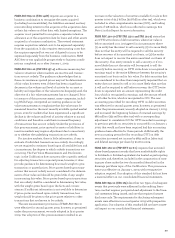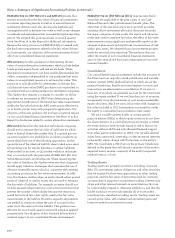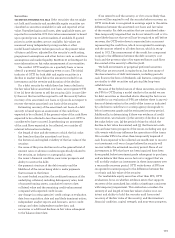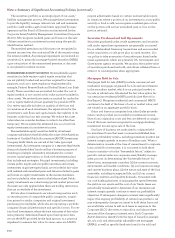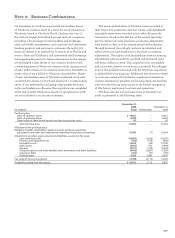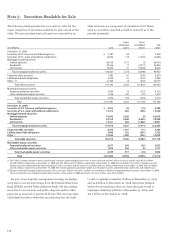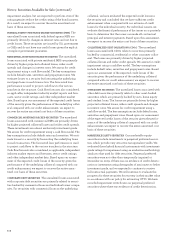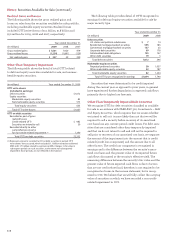Wells Fargo 2009 Annual Report Download - page 109
Download and view the complete annual report
Please find page 109 of the 2009 Wells Fargo annual report below. You can navigate through the pages in the report by either clicking on the pages listed below, or by using the keyword search tool below to find specific information within the annual report.
Derivatives and Hedging Activities
We recognize all derivatives in the balance sheet at fair value.
On the date we enter into a derivative contract, we designate
the derivative as (1) a hedge of the fair value of a recognized
asset or liability, including hedges of foreign currency exposure
(“fair value” hedge), (2) a hedge of a forecasted transaction or
of the variability of cash flows to be received or paid related
to a recognized asset or liability (“cash flow” hedge), or
(3) held for trading, customer accommodation or asset/
liability risk management purposes, including economic
hedges not qualifying for hedge accounting. For a fair value
hedge, we record changes in the fair value of the derivative
and, to the extent that it is effective, changes in the fair value
of the hedged asset or liability attributable to the hedged risk,
in current period earnings in the same financial statement
category as the hedged item. For a cash flow hedge, we record
changes in the fair value of the derivative to the extent that
it is effective in OCI, with any ineffectiveness recorded in
current period earnings. We subsequently reclassify these
changes in fair value to net income in the same period(s) that
the hedged transaction affects net income in the same financial
statement category as the hedged item. For free-standing
derivatives, we report changes in the fair values in current
period noninterest income.
For fair value and cash flow hedges qualifying for hedge
accounting, we formally document at inception the relation-
ship between hedging instruments and hedged items, our risk
management objective, strategy and our evaluation of effec-
tiveness for our hedge transactions. This includes linking all
derivatives designated as fair value or cash flow hedges to
specific assets and liabilities in the balance sheet or to specific
forecasted transactions. Periodically, as required, we also
formally assess whether the derivative we designated in each
hedging relationship is expected to be and has been highly
effective in offsetting changes in fair values or cash flows of
the hedged item using the regression analysis method or, in
limited cases, the dollar offset method.
We discontinue hedge accounting prospectively when
(1) a derivative is no longer highly effective in offsetting
changes in the fair value or cash flows of a hedged item,
(2) a derivative expires or is sold, terminated or exercised,
(3) a derivative is de-designated as a hedge, because it is
unlikely that a forecasted transaction will occur, or (4) we
determine that designation of a derivative as a hedge is no
longer appropriate.
When we discontinue hedge accounting because a deriva-
tive no longer qualifies as an effective fair value hedge, we
continue to carry the derivative in the balance sheet at its fair
value with changes in fair value included in earnings, and no
longer adjust the previously hedged asset or liability for
changes in fair value. Previous adjustments to the hedged
item are accounted for in the same manner as other compo-
nents of the carrying amount of the asset or liability.
When we discontinue cash flow hedge accounting
because the hedging instrument is sold, terminated or no
longer designated (de-designated), the amount reported in
OCI up to the date of sale, termination or de-designation
continues to be reported in OCI until the forecasted
transaction affects earnings.
When we discontinue cash flow hedge accounting because
it is probable that a forecasted transaction will not occur, we
continue to carry the derivative in the balance sheet at its fair
value with changes in fair value included in earnings, and
immediately recognize gains and losses that were accumulated
in OCI in earnings.
In all other situations in which we discontinue hedge
accounting, the derivative will be carried at its fair value in
the balance sheet, with changes in its fair value recognized in
current period earnings.
We occasionally purchase or originate financial instru-
ments that contain an embedded derivative. At inception
of the financial instrument, we assess (1) if the economic
characteristics of the embedded derivative are not clearly and
closely related to the economic characteristics of the financial
instrument (host contract), (2) if the financial instrument that
embodies both the embedded derivative and the host contract
is not measured at fair value with changes in fair value reported
in earnings, and (3) if a separate instrument with the same
terms as the embedded instrument would meet the definition
of a derivative. If the embedded derivative meets all of these
conditions, we separate it from the host contract by recording
the bifurcated derivative at fair value and the remaining host
contract at the difference between the basis of the hybrid
instrument and the fair value of the bifurcated derivative. The
bifurcated derivative is carried as a free-standing derivative at
fair value with changes recorded in current period earnings.




